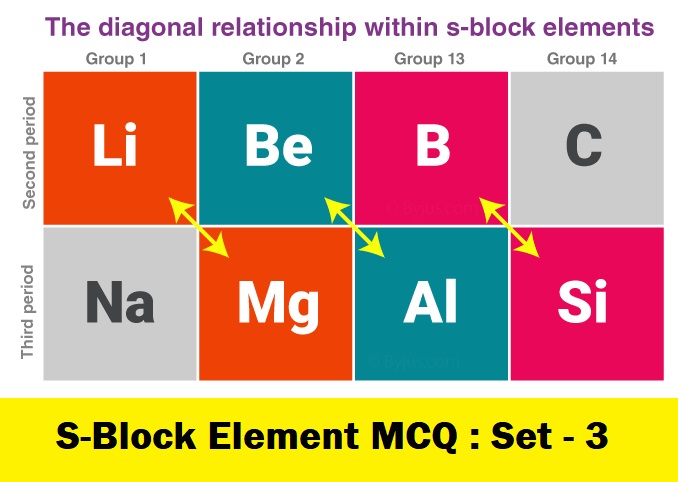CBSE Class 11 Chemistry Chapter 10 The s Block Elements Multiple Choice Questions with Answers. MCQ Questions Class 11 Chemistry The s Block Elements with Answers was Prepared Based on Latest Exam Pattern. Students can solve NCERT Class 11 Chemistry The s Block Elements MCQs with Answers to know their preparation level.
Students who are searching for NCERT MCQ Questions for Class 11 Chemistry The s Block Elements with Answers are compiled here to get good practice on all fundamentals. Know your preparation level on MCQ Questions for Class 11 Chemistry with Answers. You can also verify your answers from our provided MCQ Class 11 Chemistry The s Block Elements with Answers. So, ace up your preparation with MCQ of Chapter 10 Chemistry Objective Questions.
MCQ Questions Class 11 Chemistry The s Block Elements with Answers - Set - 3
Question 1:
Which one of the alkali metals, forms only, the normal oxide, M2O on heating in air ?
(a) Rb
(b) K
(c) Li
(d) Na
Correct Answer – (C)
Question 2 :
Which of the following has density greater than water?
(a) Li
(b) Na
(c) K
(d) Rb
Correct Answer – (D)
Question 3 :
In the case of the alkali metals
(a) the cation is less stable than the atom
(b) the cation is smaller than the atom
(c) the cation and the atom have about the same size
(d) the cation is larger than the atom
Correct Answer – (B)
Question 4 :
The metal that produces red-violet colour in the nonluminous flame is
(a) Ba
(b) Ag
(c) Rb
(d) Pb
Correct Answer – (C)
Question 5 :
Which of the following alkali metal is highly radioactive?
(a) Rubidium
(b) Caesium
(c) Francium
(d) Both (a) and (c)
Correct Answer – (C)
MCQ Questions Class 11 Chemistry The s Block Elements with Answers
Question 6 :
The elements of group 1 provide a colour to the flame of Bunsen burner due to
(a) low ionization potential
(b) low melting point
(c) softness
(d) presence of one electron in the outermost orbit
Correct Answer – (A)
Question 7 :
The element which on burning in air gives peroxide is
(a) lithium
(b) sodium
(c) rubidium
(d) caesium
Correct Answer – (B)
Question 8 :
The alkali metals have low melting point. Which of the following alkali metal is expected to melt if the room temperature rises to 30°C?
(a) Na
(b) K
(c) Rb
(d) Cs
Correct Answer – (D)
Question 9 :
Which one of the following properties of alkali metals increases in magnitude as the atomic number rises ?
(a) Ionic radius
(b) Melting point
(c) Electronegativity
(d) First ionization energy.
Correct Answer – (A)
Question 10 :
Group 2 elements are called alkaline earth metals why? Choose the correct reason(s).
(i) Hydroxides formed by group 2 elements are alkaline in nature.
(ii) Their metal oxides are found in the earth’s crust.
(iii) Their oxides are alkaline in nature
(iv) Group 2 elements react with alkalies.
(a) (i) and (ii)
(b) (ii) and (iv)
(c) (i), (ii) and (iii)
(d) (ii) and (iii)
Correct Answer – (C)
- NCERT Solutions Class 11 Chemistry Chapter 1 : Some Basic Concepts of Chemistry
- NCERT Solutions Class 11 Chemistry Chapter 2 : Structure Of The Atom
- NCERT Solutions Class 11 Chemistry Chapter 3 : Classification of Elements and Periodicity in Properties
- NCERT Solutions Class 11 Chemistry Chapter 4 : Chemical Bonding and Molecular Structure
- NCERT Solutions Class 11 Chemistry Chapter 5 : States of Matter
- NCERT Solutions Class 11 Chemistry Chapter 6 : Thermodynamics
- NCERT Solutions Class 11 Chemistry Chapter 7 : Equilibrium
- NCERT Solutions Class 11 Chemistry Chapter 8 : Redox Reactions
- NCERT Solutions Class 11 Chemistry Chapter 9 : Hydrogen
- NCERT Solutions Class 11 Chemistry Chapter 10 : The s-Block Elements
- NCERT Solutions Class 11 Chemistry Chapter 11 : The p-Block Elements
- NCERT Solutions Class 11 Chemistry Chapter 12 : Organic Chemistry: Some Basic Principles and Techniques
- NCERT Solutions Class 11 Chemistry Chapter 13 : Hydrocarbons
- NCERT Solutions Class 11 Chemistry Chapter 14 : Environmental Chemistry



